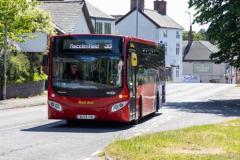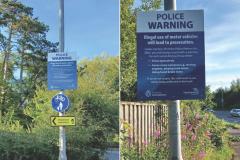On 24th and 25th June this year three narrow gauge railway locomotives and some wagons were removed by lorry from Lindow Moss.
The two foot gauge locos were recovered with permission by the Moseley Rail Trust and taken to the Apedale Railway Centre at Newcastle under Lyme. This may now have brought to a close an era of commercial peat extraction on the Moss which started in World War Two and for which there were two work sites. Over the years about six companies had operated there and a total of eight different locomotives had been in operation with wooden and metal wagons.
Of these three last ones, one loco Lister Blackstone number 50888 was built in 1959 and had arrived from Fisons Pear Works in Somerset to work for Country Kitchen Foods. This loco is believed to be unique in having its transmission converted from mechanical to hydraulic. Country Foods had another loco a Keef number 4, built 1979. The third loco number 52528, built in 1961, had come from Smithbrook Brickworks, Cranleigh Brickworks, Surrey to work here for Wrington Vale Nurseries, Racecourse Road, Wilmslow,
The wider Lindow Moss landscape has been dug for fuel since early medieval times and it is believed Lindow was the last working peat railway in the country.
Paul Moxon, from Stockton Road, remembers:
"Richard, my son, and I have fond memories of the peat bogs and our walks particularly at Christmas when the peat works were closed.
The peat works nearest to the tip on Newgate Lane used those little cableless Lister locomotives, they dug the peat and loaded it into wagons for stacking and drying in brick built barns. I once nicked a bale and took it home on the back of my push bike to see if it burned well – it didn't.
We also had the hairy tale of a former Lindow scout called Dill who nearly lost his fingers when we were messing about in one of the metal hopper wagons.
Wrington Vale Nurseries had mushroom farms in Somerset using peat but Lindow's peat was wet loaded into lorries and I was told in the 1970s it was for the mushroom factories at Harpur Hill in Buxton, a former WW2 bomb storage facility."
Jonathan Lageard writes
"I have been visiting Lindow since the 1990s when I was a PhD student at Keele University. I visited to take samples of the historic fossil pine trees under the peat. The site had peat extraction areas devoid of vegetation with large expanses of bare peat and the trunks, roots and stumps of the pines disturbed by the orange Atlas diggers. The slightly ramshackle diesel locomotive trundled on and off the site once or twice a day followed by half a dozen wooden peat wagons.
Mechanised extraction dates from the 1950s when peat workers moved here from White Moss.What looked like a large yellow snow plough pushed by a tractor was driven by Ron Critchlow. Piles of peat were then excavated into a tipper on caterpillar tracks for removal to a peat farm. In the 1990s extraction then became centred on the railway with rectangular blocks harvested following a traditional Dutch method. The site was managed by Keith Harwood with two workers.
A strong memory I have is once seeing an engine trundling off site with only the sheepdog of one of the workers sitting in the loco's driving seat apparently driving it. My tree samples were big, heavy discs and the workers very kindly let me put them on top of peat wagons to take them back to Peat Farm. They have turned out to date from four thousand years ago.
I was delighted to bump into members of the Apedale Valley Light Railway collecting the last of the diesels from Peat Farm.The locos both started first time and they are going to an excellent home in Newcastle under Lyme where they will be conserved and run."
Lindow Moss is still important today but the nature of this has changed and its great current and future value has now been recognized by the Wilmslow Neighbourhood Plan.
The plan cites its importance as a carbon store and for potential carbon capture. It also has the historical significance of being the spot where Lindow Pete was found on 1st August 1984. Rotherwood Road, adjacent to the Moss was previously called Battery Lane as it led to a 1,000 yard long volunteer rifle range know as the Butts. During the Crimean War of 1853-56 many young people joined up with local volunteers for the Rifle Brigade. Before being sent to fight they undertook training and target practice on the Butts.
Lowland bogs are very rare and Lindow is important for its role as one in a chain of sites for Cheshire wildlife. Wilmslow people have been using Lindow Moss for years for recreation and health, however informally. Restoring the bog now is of utmost importance both locally and nationally.
Article by Jon Kelly with a contribution from Alan Cooper, Wilmslow Historical Society and with the very kind help of Paul Moxon, the Industrial Railway Society, Dr Jonathan Lageard and the Apedale Valley Light Railway.
Photos by kind permission of the IRS.












Comments
Here's what readers have had to say so far. Why not add your thoughts below.
I can recommend a visit to Moseley Railway Trust at Apedale, near Newcastle Under Lyme (https://avlr.org.uk/moseley-railway-trust). As well as being a working museum for narrow gauge industrial locomotives (steam and internal combustion) they have reconstructed a WW1 trench system which features in their 'Tracks to Trenches' events, celebrating the extensive use of temporary narrow gauge railways to supply the front line.